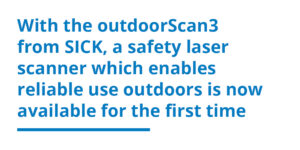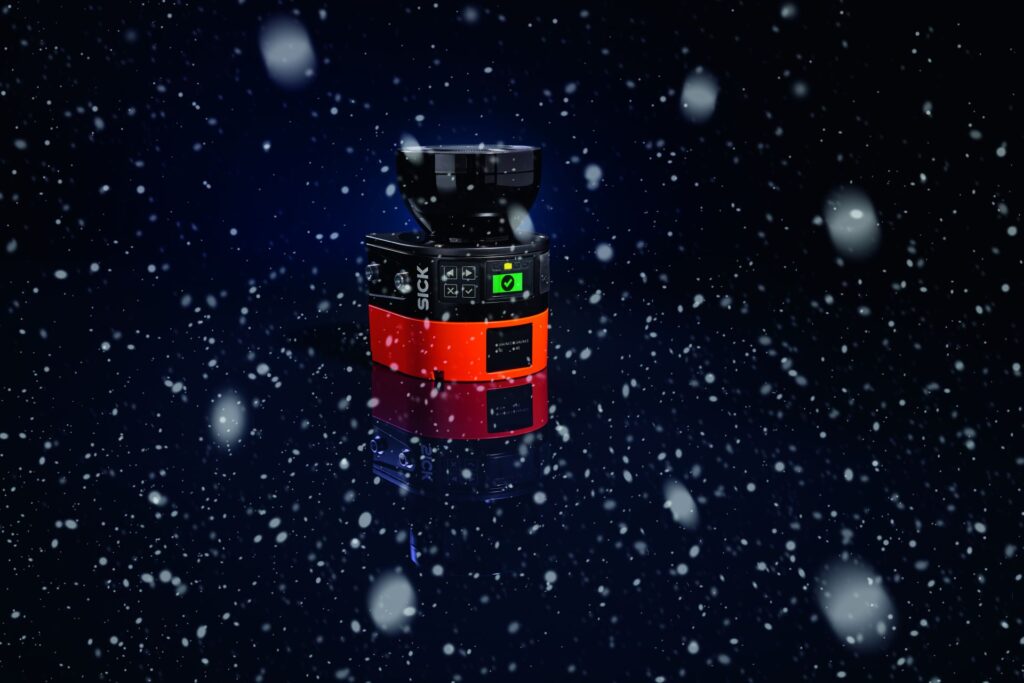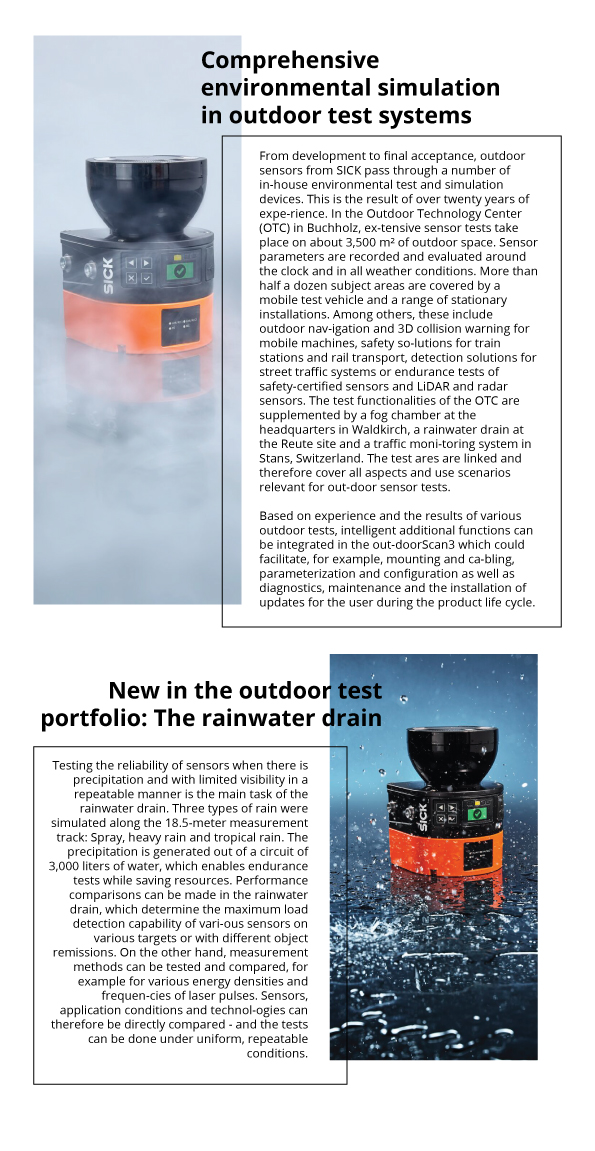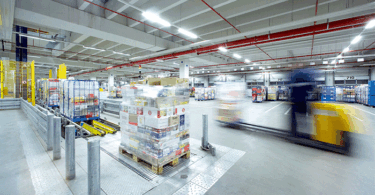Safety-certified sensors aid outdoor automation for production and logistical environments
 Taking into account the changing future application conditions of a sensor and testing under real conditions during development, SICK is ensuring the practical design of outdoor sensors. The outdoorScan3 safety laser scanner for outdoor areas has been subjected to a wide range of real and simulated open air testing. This effort was rewarded by certification.
Taking into account the changing future application conditions of a sensor and testing under real conditions during development, SICK is ensuring the practical design of outdoor sensors. The outdoorScan3 safety laser scanner for outdoor areas has been subjected to a wide range of real and simulated open air testing. This effort was rewarded by certification.
In many industrial applications, the safety function of outdoor sensors is the previously missing link for solving indoor and outdoor processes along the automation chain. An example of this is when automated guided vehicles (AGV) are moving not only in halls, but also in open areas, therefore linking different production and storage sites. While the required personal safety for indoor operations with safety-certified sensors has been the state of the art for years, additional protective measures often had to be taken for operation in outdoor areas. The disadvantage of this is that they impair the functioning and flexibility of the vehicles. With the outdoorScan3 from SICK, a safety laser scanner which enables reliable outdoor use is now available for the first time. AGV systems can now drive safely through external industrial environments. Hardware and software development as well as the safety-related certification of this sensor was supported by a wide range of test methods in the SICK open air testing facility.
Safe sensors in any weather
Sensors must withstand wind, weather and other environmental influences with high reliability and operational safety in order to be used freely outdoors. The absence of leaks as well as mechanical, chemical and thermal resistance are important basic requirements on outdoor sensors. SICK has over twenty years of experience with sensors in outdoor use. In the case of the outdoorScan3 safety laser scanner, the standardized specifications of IEC/TS 62998-1 Safety of machinery – safety-related sensors used for the protection of persons just recently went into action. In the framework of the new standard, critical environmental influences, which affect the sensor functionality and the reliability of the detection capability were defined for application indoors and outdoors. In addition, the IEC/TS 62998 also created the foundation for test concepts of the optical detection behavior and the limits on the scan technology of the safety laser scanner due to environmental influences.
Open air testing under real conditions
In particular, the limits on the reliability of the detection capability due to environmental influences must be considered, tested and validated. To do so, the device is subjected to countless tests under real conditions and in newly-developed test equipment. For example, it was tested in a fog canal and generated positive results. Even in fog with a meteorological visual range of up to 50 m, the outdoorScan3 detects all obstacles with total reliability thanks to its fogSight function. If the fog gets too thick, it safely switches to the OFF state and stops the vehicle.
The safety laser scanner was also subjected to the simulated precipitation conditions of water spray, heavy rain and tropical rain in the rainwater drain to test the limits in outdoor use. These results are also impressive. The intelligent software algorithm of the outdoorScan3 safely and reliability detects a precipitation intensity of up to 10 mm/h even through rain. High amounts of rain can cause sporadic switch-off, whereby the scanner then switches to a safe OFF state. As soon as the rain lets up, continuous operation can be continued with an automated restart.
Detection capability tests in the Outdoor Technology Center (OTC) illustrate usage under real conditions and are an additional assurance of product quality. These made it clear that the environmental influence of snow can be filtered out of the measurement data of the safety laser scanner and does not impair the safety function. The same applies for direct light penetration into the sensor: The laser scanner can work without errors even when exposed to sunlight with an illumination intensity of up to 40,000 lux. The outdoorScan3 safety laser scanner therefore offers the same safety and availability when AGV systems are moving goods over outdoor areas between halls. The certified safety can also be applied for the automated docking and disconnection of passenger boarding bridges in airports and for dangerous machines in outdoor areas.
Appropriate qualifications are needed for safety automation over the entire value creation chain, including outdoor areas. SICK not only has experience in developing safe sensors, but also has the necessary framework conditions needed to test hardware and software. The company also has finished product for availability in outdoor areas in practical simulations and under real conditions.
Want to learn more about the outdoorScan3? Contact a SICK representative today!






